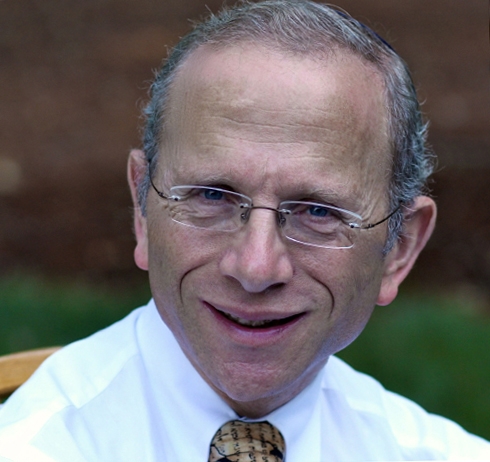Quint Lecture Explores Anti-Semitism in America

MIDDLEBURY, Vt. – Jonathan D. Sarna, the Braun professor of American Jewish history at Brandeis University, delivered the annual Hannah A. Quint Lecture in Jewish Studies at Middlebury College on November 2.
Sarna, the author of American Judiasm: A History (Yale University Press, 2005), Lincoln and the Jews (with Benjamin Shapell, Thomas Dunne Books, 2015), and several other books, addressed the topic “Is America Different? Anti-Semitism in the United States in Historical Perspective” in an insightful and sometimes humorous talk for about 60 members of the Middlebury College community.
“There are two different ways of looking at anti-Semitism in America today,” said Sarna. “A minimalist interpretation suggests that anti-Semitism is much less than meets the eye. That Jews exaggerate its significance, and the victims of anti-Semitism may be somewhat to blame for what they suffer.” On the other hand, he continued, “a maximalist interpretation warns that anti-Semitism is everywhere, even in America, and no one is immune, even those who think they are innocently and peacefully minding their own business may eventually be targeted.”
Sarna’s thesis is that there is a middle ground between the two extremes, “a centrist interpretation of anti-Semitism in America,” to which he adheres most closely in his lectures and his writing.
The guest speaker listed statistics from the Anti-Defamation League (ADL) showing that there was a 36 percent increase in anti-Semitic incidents (meaning assault, harassment, or vandalism) from 2015 to 2016, and in the first quarter of 2017 the number of incidents increased 89 percent. What Sarna finds particularly distressing about the ADL’s findings is the increased number of incidents occurring in K-12 public schools.
On social media outlets today, Sarna said, there are 43.6 anti-Semitic postings every hour, “or one post every 83 seconds.” He offered example after example of how the Internet has opened up new avenues for anti-Semitism and said, “In the new world of social media, a tiny number of people can spread a tsunami of hate and create a great wave of mayhem. No longer does anti-Semitism require a whole army of haters; now one lone wolf can terrorize thousands.”
Sarna said the minimalist view of this apparent increase in anti-Semitic incidents advances the notion: “It is much ado about nothing. [The minimalists] claim that what we are seeing is not a real danger, but a reflection of new technology. The number of hate mongers has not grown at all, they insist. Only the reach of these hate mongers has grown.”
Turning to the maximalist view, Sarna acknowledged that there has been anti-Semitism in America ever since the arrival of the first Jews on these shores in 1654. And while this tension has sometimes been counterbalanced by ambivalence toward Jews or by periods of philosemitism, or appreciation for the Jewish people, “Anti-Semitism in the United States crested in the half century preceding World War II [particularly] in the 1930s during an era of nativism and isolationism, when Jews faced physical attacks, many forms of discrimination, and intense vilification in print, on the airwaves, in movies, and on stage.”
Sarna then turned to the question posed by title of his talk: Is anti-Semitism in America different than in other countries, and if so why is it different? It is different, Sarna suggested, because “history and context and place matter greatly when studying this question,” and he offered five distinguishing factors to support his position:
- “In America, Jews have been able to fight back freely… Jews in America never had to fear losing their emancipation here.”
- Anti-Semitism has always had to compete with “other forms of animus” in this country such as anti-Christianity, anti-Quakerism, or anti-Islam. “The American strain of anti-Semitism is less strident than the European version,” Sarna said.
- “Anti-Semitism is more foreign to American ideals than to European,” and he cited the Declaration of Independence, George Washington’s letter to the Hebrew congregation in Newport, and the U.S. Constitution.
- “America’s religious tradition is actually inhospitable to anti-Semitism. Religious freedom and diversity, church-state separation, denominationalism, volunteerism – these are the key components of that great tradition and they militate against the kind of ‘us-them dichotomy’ that is so very common in the European setting.”
- “American politics resists anti-Semitism. In a two-party system where close elections are the rule, neither party can afford to alienate a major block of voters. For the most part, the politics of hatred in the United States has been confined to noisy third parties or single issue fringe groups.”
In his closing remarks, Sarna espoused his centrist position on the topic. “Anti-Semitism has always existed in America and it exists in America to this day,” he said. “I do not think we should minimize anti-Semitism, and I do not think we should maximize or exaggerate it either. Instead, the past history and the events of our own time point to the need for Jews and for all Americans to remain eternally vigilant.”
The Hannah A. Quint Lectureship in Jewish Studies was established by Eliot Levinson, a member of the Middlebury College Class of 1964, and his family to honor his mother, Hannah A. Quint. Its purpose is to provoke interest in and to deepen understanding of Jewish culture, of the religion, the history, and the literature of the Jews, and to bring a Jewish perspective to bear on ethical and political questions.

